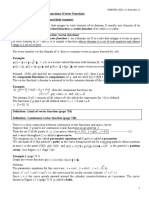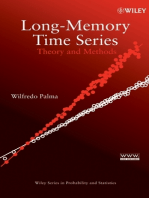Bond Price
Uploaded by
Takeshi YamadaBond Price
Uploaded by
Takeshi YamadaBond price under Ane Term Structure Model
Basic results
The dynamics of genral short rate process is dr = a(t, rt )dt + b(t, rt )dWt . Financial contracts P satises the partial dierential equation Pt + a(t, rt )Pr + b2 (t, rt ) Prr rP = 0. 2 (1)
If the dyanamics of short rate contains jump, the partial dierential equation can be written as Pt + a(t, rt )Pr + b2 (t, rt ) Prr + (t, rt )E[P (r + J) P (t)] rP = 0. 2
We assume bond price can be written as fowllows P (t, T ) = exp A(t, T ) + B(t, T )r . (1) can be written A B P = + r P t t t P = B(t, T )P r 2P = B 2 (t, T )P r2 PDE is written as follows b2 (t, rt ) 2 A B + r P + a(t, rt )B(t, T )P + B (t, T )P + (t, rt )E[P (r + J) P (t)] rP = 0. t t 2 Suppose a(t, rt ), b2 (t, rt ), (t, rt ) follow ane structure, a(t, rt ) = a0 + a1 rt , b2 (t, rt ) = b0 + b1 rt , (t, rt ) = +rt . In Gaussian, a(t, rt ) = rt , b2 (t, rt ) = 2 , (t, rt ) = +rt , In CIR a(t, rt ) = rt , b2 (t, rt ) = 2 rt , (t, rt ) = + rt . In Gaussian model, short rate process dr = ( r)dt + dWt . B = B(t, T ) 1 E[P (r + J) P (t)] + 1 t B(T, T ) = 0
A 2 = B(t, T ) B 2 (t, T ) 0 E[P (r + J) P (t)] A(T, T ) = 0 t 2 1
In CIR model, short rate process dr = ( r)dt + rdWt . B 2 = B(t, T ) B 2 (t, T ) 1 E[P (r + J) P (t)] + 1 B(T, T ) = 0 t 2 A = B(t, T ) 0 E[P (r + J) P (t)] t A(T, T ) = 0
You might also like
- Introduction to Statistical Methods for Financial Models 1st Severini Solution Manualpdf download100% (1)Introduction to Statistical Methods for Financial Models 1st Severini Solution Manualpdf download43 pages
- Positive Solutions For A Second-Order, Singular Semipositone Dynamic Boundary Value ProblemNo ratings yetPositive Solutions For A Second-Order, Singular Semipositone Dynamic Boundary Value Problem11 pages
- Calculation of Receiver Sensitivity: T V V K T ° Where T V Calibrates Voltage As TemperatureNo ratings yetCalculation of Receiver Sensitivity: T V V K T ° Where T V Calibrates Voltage As Temperature23 pages
- Calibration of The LIBOR Market Model - Implementation in PREMIANo ratings yetCalibration of The LIBOR Market Model - Implementation in PREMIA19 pages
- Proof of Newton's Universal Gravitation Law and Other Things in CalculusNo ratings yetProof of Newton's Universal Gravitation Law and Other Things in Calculus6 pages
- Analog Modulation System (1) : 4-1, 4-2,4-3, 5-1 Lecture 7, 2008-9-26No ratings yetAnalog Modulation System (1) : 4-1, 4-2,4-3, 5-1 Lecture 7, 2008-9-2623 pages
- Stochastic Calculus Final Exam With Solutions100% (1)Stochastic Calculus Final Exam With Solutions11 pages
- Cheban-Calculus 2 - CH 2 - Vector Functions - DR. Nguyen Van HoNo ratings yetCheban-Calculus 2 - CH 2 - Vector Functions - DR. Nguyen Van Ho11 pages
- Vector Differentiation: 1.1 Limits of Vector Valued FunctionsNo ratings yetVector Differentiation: 1.1 Limits of Vector Valued Functions19 pages
- Che 528 Lecture 35A Runaway Reactions CSTR: RT C 1 + T TNo ratings yetChe 528 Lecture 35A Runaway Reactions CSTR: RT C 1 + T T17 pages
- a-new-gronwall-bellman-type-integral-inequality-and-its-1d3pec18ewNo ratings yeta-new-gronwall-bellman-type-integral-inequality-and-its-1d3pec18ew16 pages
- The Handbook of Formulas and Tables For Signal ProcessingNo ratings yetThe Handbook of Formulas and Tables For Signal Processing9 pages
- Summary On Nonparametric Pricing of Interest Rate Derivative SecuritiesNo ratings yetSummary On Nonparametric Pricing of Interest Rate Derivative Securities36 pages
- 12.3 Curvature, Torsion and The TNB Frame: DT DsNo ratings yet12.3 Curvature, Torsion and The TNB Frame: DT Ds18 pages
- Stochastic Calculus For Finance II - Some Solutions To Chapter VI100% (1)Stochastic Calculus For Finance II - Some Solutions To Chapter VI12 pages
- Primer Ejercicio (Matematica 3) - CompressedNo ratings yetPrimer Ejercicio (Matematica 3) - Compressed3 pages
- Hazard Function Approach: 2.1 The Toy ModelNo ratings yetHazard Function Approach: 2.1 The Toy Model36 pages



























































